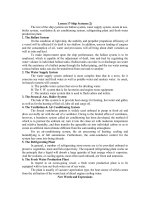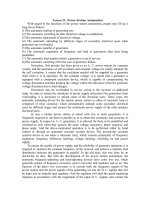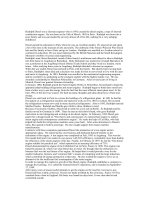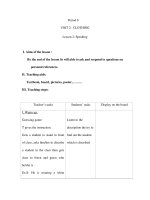Lesson 15-The power systems of Diesel Engine
Bạn đang xem bản rút gọn của tài liệu. Xem và tải ngay bản đầy đủ của tài liệu tại đây (176.25 KB, 6 trang )
Lesson 15-The power systems of Diesel Engine
The power systems of a diesel engine are a primary part of a power plant, the function
of which is to guarantee proper operation of the power plant and which mainly consist of
F. O. system, L. O. system, cooling system and compressed air system. Let us deal with
them one by one.
1. The Fuel Oil System
The basic mission of F. O. system is to supply M. E. , aux.engine and aux. boiler
with sufficient clean fuel oil.The fuel oil needed by a vessel is to be fed and stored
through oil filling port and via oil charging piping. For medium and large vessels, fuel oil
to be stored in F. O. tanks in the double bottom.
F. O. transfer pumps are required for F. O. delivery among various tanks, such as
service tank, storage tank, settling tank and separate F. O. tanks.
Any fuel oil must go through filtering, settling and centrifugal separation before it
enters the engine so as to ensure the reliable and continuous running of the engine since it
contains a certain amount of impurities and water. On the condition that a heavy oil with
high viscosity is in service, it should be pre-heated before coming into use.
Moreover, for the measurement and indication of F. O. tank level, a level gauge is
to be equipped with; for a timely mastery of M. E. oil consumption, a F. O. meter will be
relied upon; for the measurement of F. O. temperature, a thermometer is not dispensable.
In a word, the functions of F.O.system can be described as feeding,transferring,purifying,
measuring and supplying.
2. The Lube Oil System
The task of lube oil system is to provide the surfaces of different moving parts
with a moderate amount of lube oil so as to form a lubricant film and avoid a dry
friction between various parts. In addition to the reduction of friction resistance and
wearing off, the lube oil system serves to help a lot in cooling, flushing, gas tightness,
rust prevention and decrease of vibration.
Fig. 15.1
1-oil tank-két dầu ; 2-filter bầu lọc ; 3-pressure adjusting valve-van điều chỉnh áp
lực; 4-oil purifier-bộ tinh lọc dầu ; 5-filter-bộ lọc ; 6-cooler-bầu làm mát
In fact, the lube oil system for a diesel power plant can be subdivided into two
components, the inner system and the exterior one. The lube oil for the inner system
is to be provided together with that for the diesel engine; whereas most exterior
systems are of forced lubrication, with lube oil forced to each friction position by a
lube oil pump. And this lubrication method is widely used at the present time.
As usual, a low-speed marine diesel engine owns five independent lubrication systems:
(1)Lubrication for moving parts, e. g. main bearings, crosshead, etc.
(2)Lubrication for M. E. camshaft.
(3)Lubrication between piston and cylinder.
(4)Lubrication for turbocharger.
(5 )Lubrication for aux. machinery.
Furthermore, different lubrication positions should match with different kinds of lube
oil. For instance, incombustible cylinder oil with high viscosity to be adopted for the
lubrication between piston and cylinder liner since the lubrication is fulfilled under the
condition of the high temperature of combustion gas; turbine oil with low viscosity to be
employed for the lubrication of turbocharger owing to its high rpm. In respect to the rest of
the lubrication positions, general engine oil may be safely taken.
3. The Cooling System
Some mechanical equipment in a diesel power plant will turn out continuous heat during
operation, part of which derives from the hot combustion gas in cylinders and the rest of
which results from the friction of moving parts. If the above heat should not be carried away
in time, the temperature of mechanical equipment would rise, the normal lubricant film
would be damaged accordingly and even more serious accident might take place. As there
are two sides to every question, there exists a contradiction between coldness and hotness
within one diesel power plant. The only way out is to set up an effective cooling system.
Excessive temperature, as mentioned above, will lead to material damage. Does this
mean that the lower temperature the better? The answer is of course "No", for too low a
temperature will bring about a thermal stress of materials due to an abrupt drop of
temperature, not to mention heat waste, since a diesel power plant itself is a thermal
mechanism and does work by heat energy. Therefore, it is of great importance to control the
cooling water temperature properly.
The mechanical equipment of a diesel power plant to be cooled includes:
(1) Cylinder wall of M. E. and aux. engines, cylinder cover, piston, crosshead, nozzle,
turbocharger, etc.
(2) Heat exchangers, such as lube oil coolers of M. E. and aux. engines, fresh water
coolers and air coolers.
(3) Bearings, stern tube and drive units.
(4)Air compressors and other aux. machinery.
For M. E. cooling, there are two types for your choice, i. e. open circulation and closed
circulation. Ocean-going vessels prefer the latter to the former because of the shortcomings
of the former. A closed circulation is composed of sea water pump, fresh water pump, lube
oil cooler, fresh water cooler, F. W. expansion tank and pipeline with valves.
4. The Compressed Air System
Compressed air is generally adopted on board the ship. Apart from starting M. E. &
aux. engines, it can be used for air siren, pneumatic tools, flushing,, charging for S. W. or
F. W. , pressure tanks and control of self-regulated devices. The compressed air system
usually consists of air compressors, separators, air reservoirs and pipelines with different
valves.
New Words and Expressions
1. power system hệ động lực
2. power plant trang bị động lực
3. fuel oil (F. O.) dầu đốt
4. lube oil (L.O.) dầu bôi trơn
5. cooling system hệ làm mát
6. compressed air khí nén
7. aux. engine máy phụ
8. aux. boiler nồi hơi phụ
9. oil filling port miệng nạp dầu
10. oil charging piping ống nạp dầu
11. F. O. tank két dầu đốt
12. fresh water (F. W.) nước ngọt
13. transfer pump bơm chuyển
14. service tank két trực nhật
15. storage tank két chứa
16. settling tank két lắng
17. filter n.bộ lọc
18. settle v. lắng đọng
19. centrifugal a .ly tâm
20. separation n.phạn ly
21. impurity n.tạp chất
22. heavy oil dầu nặng
23. viscosity n độ nhớt
24. pre-heat v.gia nhiệt trước,đun nóng trước
25. indication n.chỉ thị,biểu thị
26 level n mức
27. level gauge đồng hồ đo mức
28. oil consumption tiêu thụ dầu
29. F. O. meter đồng hồ đo lưu lượng dầu đốt
30. thermometer n. nhiệt kế
31. dispensable a có thể bỏ qua,có thể miễn trừ
32.feed v.cấp
33. purify v .làm tinh khiết
34. lubricant film màng dầu bôi trơn
35. flush v.dội nước làm sạch (flush the toilet)
36. rust prevention phòng gỉ
37. forced lubrication bôi trơn cưỡng bức
38. lube oil pump bơm dầu nhờn
39. cylinder oil dầu xylanh
40. cylinder liner áo lót xy lanh
41. combustion gas khí cháy
42. turbine oil dầu tuabin
43. engine oil dầu máy
44. contradiction n.sự mâu thuẫn,sự trái ngược
45. thermal stress ứng suất nhiệt
46. thermal mechanism cơ chế nhiệt
47. cylinder wall thành xylanh
48. heat exchanger bộ trao nhiệt
49. cooler n bầu làm mát
50. drive unit trang bị truyền động
51. air compressor máy nén khí
52. open circulation tuần hoàn mở
53. closed circulation tuần hoàn đóng
54. expansion tank két giãn nở
55. air siren còi khí
56. pneumatic tool công cụ dùng khí nén
57 . charge v.nạp (điện,khí...)
58. pressure tank két áp lực
59. self-regulated device thiết bị tự điều tiết
60. separator n.máy phân ly
61. air reservoir bình chứa khí nén
Verb Phrases and Collocations
1. come into use bắt đầu sử dụng
2. in a word nói tóm lại
3. a moderate amount of một lượng vừa phải
4. wear off bị mài mòn
5. There are two sides to every question.có hai mặt của mỗi vấn đề
6. the only way out lối ra duy nhất
7. prefer A to B thích A hơn B
BÀI 15-HỆ THỐNG ĐỘNG LỰC CỦA MÁY DIESEL
Hệ thống động lực của một động cơ diesel lả bộ phận căn bản của hệ động lực
,nhiệm vụ của nó là đảm bảo khai thác tốt hệ động lực và nó chủ yếu gồm hệ dầu đốt,hệ
dầu nhờn,hệ làm mát và hệ khí nén.Chúng ta hãy lần lượt đề cập tới từng hệ thống
1.Hệ dầu đốt
Nhiệm vụ cơ bản của hệ dầu đốt là cung cấp đầy đủ dầu đốt sạch cho máy
chính,máy phụ và nồi hơi phụ .Dầu đốt cần thiết được cấp và lưu chứa cho tàu thông qua
miệng nạp dầu và hệ đường ống.Với các tàu lớn và trung bình,dầu đốt được chứa trong
các két dầu đốt nằm dưới đáy trong
Bơm lưu chuyển dầu đốt làm nhiệm vụ chuyển dầu giữa các két khác nhau như
két trực nhật,két chứa,két lắng và các két dẩu đốt tách bạch khác nhau.Bất kỳ dầu đốt nào
cũng phải qua việc lọc,lắng và phân ly ly tâm trước khi đi vào máy để đảm bảo máy chạy
liên tục và tin cậy bởi vì dầu đốt có chứa một lượng nào đó tạp chất và nước.Trong điều
kiện sử dụng dầu nặng có độ nhớt cao,ta phải gia nhiệt trước khi cho dầu vào sử dụng.
Ngoài ra phải trang bị đồng hồ đo mức để đo và chỉ thị mức của két dầu đốt
;đồng hồ đo dầu đốt giúp ta nắm vững kịp thời mức sử dụng dầu của máy chính ,còn
nhiệt kế là vật không thể thiếu được để đo nhiệt độ của dầu đốt.Nói tóm lại ,chức năng
của hệ dầu đốt có thể mô tả như sau :tiếp nhận dầu,chuyển vận,tinh lọc ,đo và cung cấp.
2.Hệ bôi trơn
Nhiệm vụ của hệ bôi trơn là cấp cho bề mặt của các chi tiết chuyển động một
lượng dầu nhờn vừa phải để hình thành nên một màng bôi trơn và tránh cho ma sát khô
giữa các bộ phận khác nhau.Ngoài việc giảm sức cản ma sát và mài mòn,hệ thống dầu bôi
trơn còn hỗ trợ trong một loạt việc như làm mát,dội rửa,làm kín khí,phòng gỉ mòn và
giảm rung động.
Thực ra,hệ bôi trơn động lực diesel có thể chia thành hai thành phần,hệ thống
trong và hệ ngoài.Dầu bôi trơn của hệ trong được cung cấp cùng với dầu cấp cho động cơ
diesel,trong khi hệ thống ngoài là bôi trơn cưỡng bức với dầu bôi trơn được bơm đẩy vào
mỗi vị trí ma sát.Và phương pháp bôi trơn này hiện nay được sử dụng rộng rãi.Thông
thường,một động cơ diesel có 5 hệ bôi trơn độc lập:
(1)bôi trơn các chi tiết chuyển động như ổ đỡ chính,đầu khuỷu
(2)bôi trơn trục cam của máy chính
(3)bôi trơn giữa piston và xylanh
(4)bôi trơn tuabin
(5)bôi trơn máy phụ
Ngoài ra.các vị trí bôi trơn khác nhau sẽ thích hợp với các loại dầu bôi trơn khác
nhau.Ví dụ dầu xy lanh không cháy được với độ nhớt cao được dùng để bôi trơn giữa
piston và áo xylanh bởi vìviệc bôi trơn được tiến hành trong điều kiện nhiệt độ cao của
khí cháy;dầu tuabin với độ nhớt thấp được dùng để bôi trơn tuabin có vòng quay cao. Với
những vị trí bôi trơn còn lại ,dầu máy tổng hợp được dùng coi là an toàn
3-Hệ làm mát
Một số trang bị cơ khí trong động lực diesel sẽ liên tục toả nhiệt trong khi hoạt
động;một phần nhiệt sinh ra từ khí cháy trong xy lanh phần còn lại từ ma sát của các chi
tiết chuyển động.Nếu nhiệt đó không được giải toả đúng lúc,nhiệt độ của bộ phận cơ khí
sẽ tăng lên ,màng bôi trơn bình thường vì thế sẽ hỏng và nhiều hư hỏng nghiêm trọng
khác có thể xảy ra.Vì mỗi một sự việc đều có hai mặt,cho nên có điều mâu thuẫn giữa
cái lạnh và cái nóng trong một động lực diesel.Lối thoát duy nhất là thiết lập một hệ
thống làm mát có hiệu quả .Như đã nói ở trên,nhiệt độ quá cao sẽ dẫn tới việc hư hỏng
vật liệu.Thế có nghĩa là nhiệt độ thấp hơn thì tốt hơn?Tất nhiên câu trả lời là “không”,đó
là vì nhiệt độ quá thấp sẽ tạo ra ứng suất nhiệt trong vật liệu do nhiệt độ giảm đột
ngột,đó là chưa nói tới tổn thất nhiệt bởi vì động lực diesel bản thân nó là một cỗ máy
nhiệt và hoạt động bởi nhiệt năng.Bởi vậy .việc khống chế nhiệt độ nước làm mát cho
đúng mức là cực kỳ quan trọng.Các bộ phận cơ củađộng lực diesel cần được làm mát
gồm có:
(1)thành xylanh của máy chính và máy phụ,nắp xylanh,piston,đầu khuỷu,vòi
phun,tuabin...
(2)cácbộ trao nhiệt như bầu làm mát dầu nhờn của máy chính và máy phụ ,bầu
làm mát nước ngọt và bầu làm mát khí
(3)Ổ đỡ,ống đuôi và các bộ phận dẫn động
(4)Máy nén khí và các máy phụ khác









